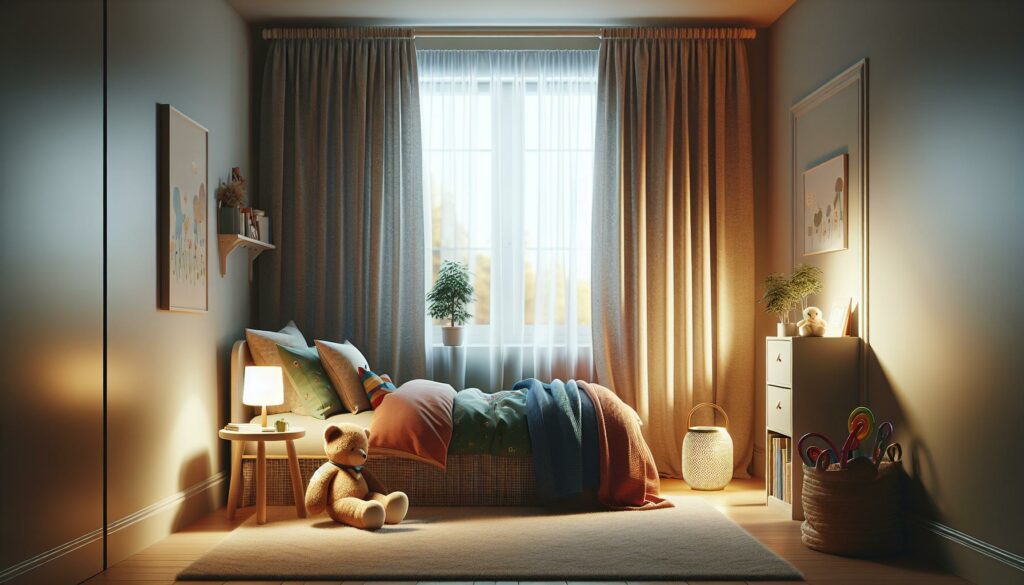As a parent, I know how concerning it can be to watch your toddler toss, turn and cry during sleep. These nighttime disturbances aren’t just difficult for our little ones – they often leave us feeling helpless and exhausted too. So what happens when you see a toddler restless and crying in sleep?
I’ve spent years researching sleep patterns in young children and understand that restless sleep in toddlers is actually more common than you might think. From night terrors to sleep regressions, there are several reasons why your child might be experiencing these unsettling episodes. The good news? Most sleep disturbances are completely normal parts of early childhood development and can be managed with the right approach.
Key Takeaways
- Toddler sleep disturbances are common and often a normal part of early childhood development, typically involving night terrors, restlessness, and crying during sleep cycles
- Normal toddler sleep cycles last 90-120 minutes, alternating between 4 stages: drowsiness, light sleep, deep sleep, and REM sleep, with 1-2 normal night wakings
- Common causes include night terrors (affecting 3-6% of toddlers), physical discomfort like teething or ear infections, environmental factors, and changes in routine
- Sleep disruptions can significantly impact behavior and cognition, leading to increased tantrums, reduced attention span, and decreased learning capacity
- Creating a consistent bedtime routine and optimizing sleep environment (temperature 68-72°F, white noise, blackout curtains) can help improve sleep quality
- Consult a healthcare provider if your toddler shows persistent symptoms like frequent breathing pauses, excessive sweating, or sleep disruptions occurring 5+ nights weekly
Toddler Restless and Crying in Sleep
Toddler sleep patterns follow distinct cycles throughout the night, with transitions between light and deep sleep phases. These patterns create natural windows when sleep disturbances are more likely to occur.
Normal Sleep Cycles vs. Disrupted Sleep
A typical toddler sleep cycle lasts 90-120 minutes, alternating between non-REM and REM sleep phases. During normal sleep cycles, toddlers move through 4 stages:
- Drowsiness: Light sleep with occasional body movements
- Light sleep: Regular breathing with brief movements
- Deep sleep: Minimal movement with steady breathing
- REM sleep: Rapid eye movements with increased brain activity
Disrupted sleep patterns show these key differences:
- Frequent wakings (more than 2-3 times per night)
- Extended periods of restlessness lasting over 10 minutes
- Difficulty transitioning between sleep cycles
- Irregular breathing patterns during rest periods
Common Signs of Sleep Disturbance
Physical indicators of sleep disruption in toddlers include:
- Thrashing movements during rest periods
- Crying out without fully waking
- Sweating despite comfortable room temperature
- Rapid breathing or gasping sounds
- Increased irritability before naptime
- Difficulty focusing on daily activities
- Rubbing eyes frequently after adequate rest
- Falling asleep during regular play times
| Sleep Pattern Indicator | Normal Range | Potential Concern |
|---|---|---|
| Night Wakings | 1-2 times | More than 3 times |
| Sleep Duration | 11-14 hours | Less than 10 hours |
| Time to Fall Asleep | 15-30 minutes | Over 45 minutes |
| Nap Duration | 1-3 hours | Less than 30 minutes |
Causes of Restless Sleep in Toddlers
Toddler sleep disturbances stem from multiple factors that affect their sleep quality and duration. Here’s a detailed examination of the primary causes that contribute to restless sleep patterns in toddlers.
Night Terrors and Nightmares
Night terrors affect 3-6% of young children between ages 2-4 years. During night terrors, toddlers remain in deep sleep while appearing distressed, screaming or crying. Unlike nightmares that occur during REM sleep, night terrors emerge during non-REM sleep transitions between sleep cycles. Common triggers include:
- Overtiredness from missed naps or late bedtimes
- Irregular sleep schedules disrupting natural sleep cycles
- Stress from major changes like starting daycare or moving homes
- Genetic predisposition if parents experienced night terrors
Physical Discomfort and Health Issues
Physical factors directly impact sleep quality in toddlers. Medical conditions that commonly disturb toddler sleep include:
- Teething pain from emerging molars
- Ear infections causing pressure discomfort
- Acid reflux symptoms intensifying when lying flat
- Sleep apnea characterized by snoring or breathing pauses
- Growing pains affecting legs during sleep hours
| Common Health Issues | Percentage of Affected Toddlers |
|---|---|
| Teething Pain | 70-80% |
| Ear Infections | 80% by age 3 |
| Sleep Apnea | 1-5% |
| Growing Pains | 25-40% |
- Room temperature variations outside 68-72°F (20-22°C)
- Excessive noise from household activities or outdoor sources
- Bright lights from electronics or street lamps
- Uncomfortable bedding materials or sleepwear
- Unfamiliar sleep environments during travel or transitions
- Changes in routine affecting natural sleep-wake cycles
Impact of Sleep Disruption on Toddler Development
Sleep disruptions affect multiple aspects of a toddler’s development, with observable changes in both behavior and cognitive function. Research from the Journal of Pediatrics indicates that children who experience frequent sleep disturbances show measurable differences in developmental outcomes compared to well-rested peers.
Behavioral Changes
Disrupted sleep patterns create significant behavioral shifts in toddlers:
- Increased irritability during daytime activities like playtime or meals
- Frequent emotional outbursts with 3-4x more tantrums per day
- Reduced attention span, lasting 2-3 minutes versus the typical 5-7 minutes
- Difficulty following simple instructions or routines
- Physical aggression toward siblings or peers
- Resistance to transitions between activities
- Decreased interest in previously enjoyed activities
| Behavior Category | Well-Rested Toddler | Sleep-Disrupted Toddler |
|---|---|---|
| Daily Tantrums | 1-2 | 4-6 |
| Attention Span | 5-7 minutes | 2-3 minutes |
| Activity Changes | 3-4 smooth | 6-8 with resistance |
- Memory consolidation deficits, particularly in new skill acquisition
- 20-30% decrease in vocabulary learning capacity
- Reduced problem-solving abilities in simple tasks
- Slower processing speed during educational activities
- Impaired pattern recognition skills
- Delayed response time to verbal instructions
- Diminished creative play engagement
| Cognitive Area | Impact Percentage | Recovery Timeline |
|---|---|---|
| Memory | -25% | 3-4 days |
| Learning Speed | -30% | 2-3 days |
| Focus Duration | -40% | 1-2 days |
Solutions for Better Sleep Quality
Improving toddler sleep quality requires implementing evidence-based strategies that address both behavioral and environmental factors. Here’s a comprehensive approach to enhance your toddler’s sleep experience.
Creating a Consistent Bedtime Routine
A consistent bedtime routine signals the body to prepare for sleep through predictable activities. Follow these structured steps:
- Start the routine 30 minutes before bedtime
- Give a warm bath at the same time each night
- Dress in comfortable sleepwear made of breathable fabrics
- Read 1-2 short bedtime stories in a quiet voice
- Dim the lights progressively during the routine
- Play soft white noise or gentle lullabies
- Offer a security object like a stuffed animal or blanket
- Keep goodnight kisses brief & consistent
- Set room temperature between 68-72°F (20-22°C)
- Install blackout curtains to block external light
- Use a white noise machine set at 50-60 decibels
- Remove electronic devices & bright alarm clocks
- Position the bed away from heating/cooling vents
- Choose a firm mattress with breathable bedding
- Maintain humidity levels between 30-50%
- Install a dim nightlight if needed for comfort
| Environmental Factor | Optimal Range | Impact on Sleep |
|---|---|---|
| Room Temperature | 68-72°F | Promotes deeper sleep |
| Sound Level | 50-60 dB | Masks disruptive noise |
| Humidity | 30-50% | Prevents respiratory discomfort |
| Light Level | <5 lux | Supports melatonin production |
When to Consult a Healthcare Provider
Medical intervention becomes essential when a toddler’s sleep disturbances significantly impact their daily functioning or show signs of underlying health concerns. Here’s what parents need to monitor and when to seek professional help.
Warning Signs to Watch For
- Persistent loud snoring 3+ nights per week
- Frequent pauses in breathing lasting 10+ seconds
- Gasping or choking sounds during sleep
- Extreme sweating during sleep despite normal room temperature
- Unusual daytime sleepiness or falling asleep during activities
- Morning headaches
- Behavioral changes lasting more than 2 weeks:
- Increased aggression
- Difficulty concentrating
- Hyperactivity
- Excessive irritability
- Sleep disruptions occurring 5+ nights per week for over a month
- Regular bedwetting after age 5
- Persistent teeth grinding causing dental issues
Professional Sleep Assessment
A sleep assessment involves specialized evaluation methods to identify underlying sleep disorders:
- Sleep diary documentation tracking:
- Bedtime routines
- Wake times
- Number of night wakings
- Duration of sleep episodes
- Daytime behavior patterns
Professional evaluation tools include:
| Assessment Type | Duration | Purpose |
|---|---|---|
| Polysomnography | 8-12 hours | Monitors brain waves, oxygen levels & body movements |
| Actigraphy | 1-2 weeks | Tracks sleep-wake patterns using wearable device |
| Multiple Sleep Latency Test | 4-5 naps | Measures daytime sleepiness |
- Medical history
- Physical symptoms
- Environmental factors
- Family sleep patterns
- Developmental milestones
- Current medications
- Dietary habits affecting sleep
Implementing Consistent Bedtime Routines
Understanding your toddler’s sleep patterns and addressing their sleep concerns is vital for their overall well-being. I’ve seen how implementing consistent bedtime routines and creating the right sleep environment can make a significant difference in reducing toddler restless and crying in sleep.
While occasional sleep disturbances are normal remember that you’re not alone in dealing with these challenges. I encourage you to trust your parental instincts and seek professional help if you notice persistent issues affecting your child’s sleep quality or daily functioning.
With the right approach and support your toddler can develop healthy sleep habits that’ll benefit their growth and development for years to come.



